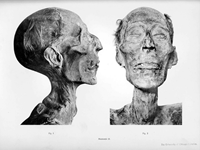These Hubble images show Jupiter in ultraviolet and near-infrared light (first image) and visible light (second image).
Hubble's capacity to observe in the ultraviolet, visible and near-infrared wavelengths, combined with its long-term work, led to the OPAL (Outer Planetary Atmospheres Legacy) program.
For more than 10 years, Hubble has supported the OPAL program, tracking changes in the atmospheres of the planets in our solar system. Regular observations of Jupiter have tracked cloud movements and measured wind speeds, storms and vortices.
Unlike Earth, Jupiter has an axis tilt of only three degrees (Earth's tilt is 23.5 degrees). While this might seem to preclude seasonal changes, the planet's distance from the Sun varies by about 5% over its 12-year orbit. This is why OPAL carefully studies seasonal effects in the atmosphere.
Image description:
Two images reveal the wealth of information provided by the spectral filters on Hubble's Wide Field Camera 3 science instrument. In the first image, the Hubble image of Jupiter was created using three filters with wavelengths similar to the colors seen by the human eye: F395N blue, F502N green, F658N red. In the second image, the wavelength limits were extended beyond the visible range into the ultraviolet and infrared regimes: F343N is blue, F467M is green, FQ889N is red. Humans cannot detect these extended wavelengths. The result is a live disk that shows highly UV-absorbing haze as orange (over the poles and in three major storms, including the Great Red Spot) and newly formed ice as white (compact storm clouds just north of the equator). These filters (and others not shown here) allow astronomers to study differences in cloud thickness, height and chemical structure.
Image credits: NASA, ESA, Amy Simon (NASA-GSFC), Michael H. Wong (UC Berkeley); Image Processing: Joseph DePasquale (STScI)


 Nielawore
Nielawore










Yorumlar
lovely
nice
Yorum yazmak için lütfen giriş yapınız